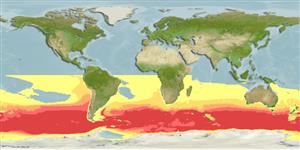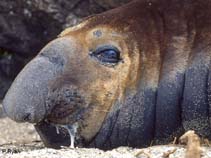Mirounga leonina (Linnaeus, 1758)
Southern elephant seal| Native range | All suitable habitat | Point map | Year 2050 |

|
| This map was computer-generated and has not yet been reviewed. |
| Mirounga leonina AquaMaps Data sources: GBIF OBIS |
Classification / Names Common names | Synonyms | CoL | ITIS | WoRMS
Mammalia | Carnivora | Phocidae
Environment: milieu / climate zone / depth range / distribution range Ecology
Pelagic-neritic; depth range 0 - 8000 m (Ref. 1394), usually 1000 - 5000 m. Polar; 0°N - 90°S, 180°W - 180°E
Distribution Countries | FAO areas | Ecosystems | Occurrences | Introductions
Indo-Pacific, Atlantic Ocean and the Antarctic: Circumpolar in the Southern Hemisphere, Skeleton coast of Namibia around the Cape to Ilha Bazaruto in Mozambique. Polar, temperate.
Length at first maturity / Size / Weight / Age
Maturity: Lm ? range ? - ? cm Max length : 685 cm TL male/unsexed; (Ref. 99323); 300 cm TL (female); max. published weight: 5.0 t (Ref. 99323); max. published weight: 5.0 t
Prefers sandy and cobble beaches, but will haul out on ice, snow or rocky terrace); they venture inland into tussock grass and other vegetation, and frequently lie in mud wallows. Feeds on 75% cephalopods and 25% fish. Maximum measurements for female species based from Ref. 1394. Reported from 0 m- m (Ref. 1394) but is observed to occur at greater depths based on more recent data (Kaschner, K. pers. comm., 20/10/14). Prefers sandy and cobble beaches, but will haul out on ice, snow or rocky terraces; they venture inland into tussock grass and other vegetation, and frequently lie in mud wallows. Feeds on 75% cephalopods and 25% fish (Ref. 1394).
Life cycle and mating behavior Maturity | Reproduction | Spawning | Eggs | Fecundity | Larvae
Main reference
References | Coordinator | Collaborators
Jefferson, T.A., S. Leatherwood and M.A. Webber. 1993. (Ref. 1394)
IUCN Red List Status (Ref. 130435)
Least Concern (LC) ; Date assessed: 12 December 2014
CITES status (Ref. 108899)
Appendix II: International trade monitored
CMS (Ref. 116361)
Not Evaluated
Threat to humans
Human uses
Fisheries: commercial
FAO - Fisheries: species profile | FishSource | Sea Around Us
Tools
More information
Internet sources
BHL | BOLD Systems | CISTI | DiscoverLife | FAO(Fisheries: species profile; publication : search) | Fishipedia | GenBank (genome, nucleotide) | GloBI | Gomexsi | Google Books | Google Scholar | Google | PubMed | Tree of Life | Wikipedia (Go, Search) | Zoological Record
Estimates based on models
Preferred temperature
(Ref. 115969): 0.1 - 1.6, mean 0.8 (based on 16947 cells).
Price category
(Ref. 80766):
Unknown.



